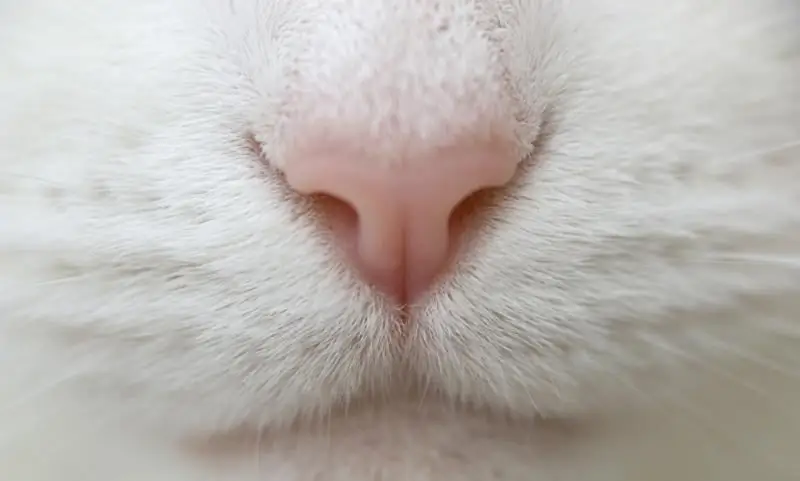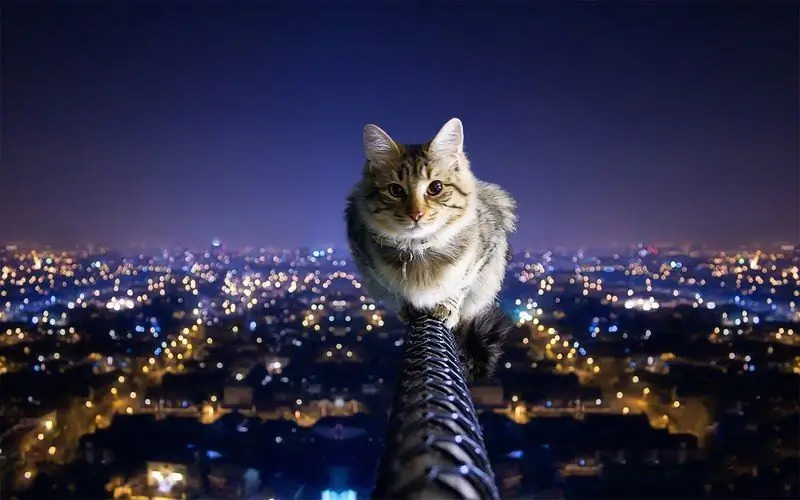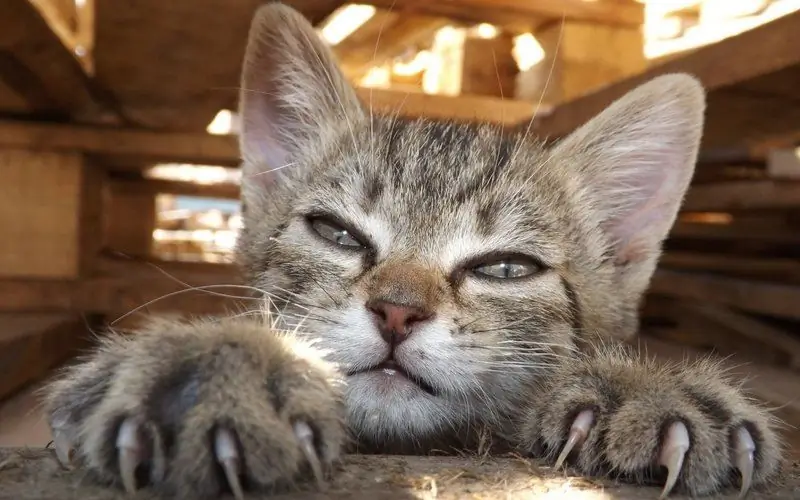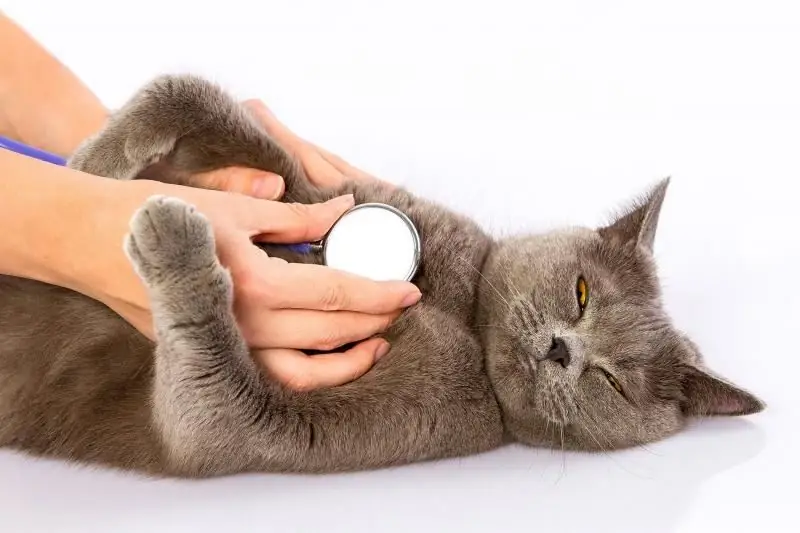
Table of contents:
- Author Bailey Albertson [email protected].
- Public 2024-01-17 22:26.
- Last modified 2025-06-01 07:32.
Question about the nose

Just one useful habit, which does not require much effort and time, allows you to contact your veterinarian at the first sign of discomfort in a cat and not leave her alone with the disease. It is a habit to regularly pay attention to the cat's nose.
Content
- 1 Do I need to monitor the condition of the cat's nose
- 2 What should be the nose of a healthy cat
-
3 Changes in indicators, as evidenced by them
- 3.1 Dry nose and its causes
-
3.2 Warm or cold: what affects the temperature
3.2.1 Photo gallery of nasal discharge in cats:
-
3.3 Nose color and spots
3.3.1 Photo gallery about spots on the nose in cats:
-
3.4 Nose shape
3.4.1 Photo gallery about the treatment of narrowing of the nasal passages:
- 4 How to care for a cat's nose
- 5 Testimonials from cat owners about nose care
Do I need to monitor the condition of the cat's nose?
The condition of the cat's nose must be monitored; it is not difficult, the nose is always available for inspection. The temperature and humidity of the nose are checked by lightly touching the back of the hand to the nose. Preliminary conclusions can be drawn from the condition of the nasal mirror. But given the easy availability of the cat nose, it is a valuable source of information about changing health conditions. A healthy nose usually indicates that the cat itself is healthy.
What should be the nose of a healthy cat
Externally, in the structure of the nose, the apex, back, root and sides are distinguished. The top (lobe) of the nose is not covered with hair, it has two nostrils. The nose is the initial section of the respiratory system. The nasal cavity is divided into two parts by a cartilaginous septum; paired nasal passages have a tortuous course; they are covered with a mucous membrane. Passing through the nasal passages, the air is humidified, warmed, partially cleared of microscopic inclusions, bacteria and viruses, and then used by the cat for breathing. The nasal passages block the incoming air flow; the odorous substances contained in it dissolve in the mucus covering the epithelium and become available to the olfactory receptors. A cat's sense of smell is 15-20 times sharper than that of humans. The nasal cavity communicates with the space of the paranasal sinuses,which are located between the plates of the flat bones of the skull and also contain olfactory receptors in their mucous membrane. Inflammatory diseases of the nasal cavity are often complicated by inflammation of the paranasal sinuses. The nasal cavity communicates with the external environment through the nostrils; with a throat - through special holes - choanas; with the eye socket - through the nasolacrimal canal.

The appearance of the unpigmented nose is normal: pink, uniform color, the skin of the nose is intact and slightly shiny from moisture, no discharge from the nostrils, the hair around the nose is clean
The cat also possesses an additional organ of smell called the Jacobson organ; it is located in the region of the upper incisors above the palate. The cat uses it by inhaling air through its mouth. Scientists suggest that a cat prefers to smell pleasant smells through its nose; and the unpleasant ones - with the help of the Jacobson organ.
The appearance of a cat's nose is highly dependent on its breed and color. If we compare the side views of photographs of representatives of different breeds of cats, then the difference in the length of the nose can reach several centimeters. The shortest noses are typical for Persian cats, as well as British and Scottish folds. The shortening of the nasal passages in these breeds makes them susceptible to infectious diseases of the upper respiratory system.
The color of the nose lobe can change with age and also depend on the ambient temperature. For example, it is noted that with a decrease in temperature, a pigmented nose becomes darker, and a light-colored nose becomes lighter. With age, the color of the nose may become darker. The color of the nose is usually in harmony with the color of the muzzle, maybe a few colors darker. Certain colors, such as tricolors, have congenital pigmentation spots on the nose.

The presence of a dark birthmark with clear boundaries, constant shape, size and color against the background of unpigmented skin of the nose lobe, the skin over the birthmark is not changed - this is the norm
A healthy cat's nasal mirror feels cool and slightly damp to the touch; moisture in the nose is provided by the work of special mucous glands; the mucus is quite thick and promotes the capture, retention and dissolution of odorous substances, facilitating their contact with the olfactory receptors. And also mucus serves as a kind of protective lubricant for a delicate nasal speculum; with insufficient mucus production, cracks, crusts, wounds may appear on the nose. The water contained in the mucus evaporates from the surface of the nose, cooling it down and causing a feeling of coolness when touched. Drying of the nasal mirror is very painful for the cat, and significantly reduces its sense of smell. The hair around the nose is normal - dry and fluffy, there are no traces of discharge on it. The cat breathes freely and practically silently through its nose.
Additionally, a wet nasal mirror partially takes over the function of thermoregulation, helping to cool the cat's body.
Changes in indicators, what they indicate
Changes in the condition of the cat's nose may indicate both a change in the state of its body within the physiological norm, and the development of a serious pathology, which allows an attentive owner to consult a veterinarian in time and prevent possible complications in a beloved animal. External factors can also affect the condition of the nose.
Dry nose and its causes
Normally, a cat has a dry nose in a dream, as well as the next half hour after waking up. This is because the secretion of the mucous glands decreases during sleep. If the nose continues to be dry, this is a good reason for thermometry.
A dry nose can also be under stress or after exercise; During play, the nose can change its state from wet to dry several times, since the nose tends to reflect the reaction of the feline body to physical activity.
Dryness of the nose can also be caused by heat and dry air; under these conditions, moisture evaporates faster from the cat's nose, and the glands do not have time to replenish the lubricant. The cat will often lick its lips to try to compensate for moisture. It is necessary to ensure that the cat always has drinking water to replenish the lack of fluid.
With fever, the nose becomes dry and also hot for a long time; this is due to both increased body temperature and a lack of fluid in the body, which accompanies fever. Fever - A cat's body temperature rises above 39 ° C. All cases of fever are a reason to contact your veterinarian.
Some cats are prone to dry noses due to breed characteristics, such as Bengals.
It is worth paying attention to cat nasal discharge; they are not normally present, and they have nothing to do with normal nasal lubrication. Standing out from the nasal passages, they stain the coat and form crusts. The cat sneezes, her sense of smell dulls, which leads to a loss of appetite. Nasal discharge should never be ignored. So, viral infections at the onset of the disease are characterized by mucous transparent discharge from the nose, when the bacterial flora is attached, the discharge becomes purulent. A mucous discharge from only one nostril may indicate the presence of a foreign body that the cat could accidentally inhale, as well as a polyp in the nasal cavity. In the presence of a tumor, discharge from one nostril with an admixture of blood is characteristic. Allergies are characterized by profuse clear nasal discharge. With injuries, nosebleeds may develop. The presence of discharge from the nose in a cat is always a reason to contact the veterinarian.
Warm or cold: what affects the temperature
First of all, this is influenced by subjective perception, since the difference in body temperature between a cat and a person is approximately 2 ° C. Next are the factors discussed above that cause dry nose; because the water evaporating from the secretions of the nasal glands causes cooling of the nose. The temperature of the nose and its humidity are closely related; for example, at the very beginning of a cold, with an onset of fever, the nose may already be warm, but still moist. If the fever persists, the nose will become dry and hot.
There is one dire symptom associated with the temperature and moisture in the cat's nose. It is a wet and very cold nose. Such a nose is an acute circulatory failure - shock; which can be caused by low fever, burns, electric shock, allergies, poisoning, trauma, inflammatory disease, or other causes. Shock is necessarily accompanied by depression of the cat's consciousness and physical activity. The mucous membranes available for examination are pale or bluish in color; pulsation in the main arteries is weakened, ears and paws are cold, breathing is shallow. Shock is a life-threatening condition; the cat must be urgently taken to the nearest veterinary hospital with resuscitation. Before transportation, call the clinic, this will ensure the readiness of the resuscitator; wrap the cat in something warm; if the cause was an injury - ensure immobility during transportation by placing it on a smooth hard surface (shield) on its side; monitor the cat's condition in dynamics. It is important to act extremely quickly; Cats, unlike humans and dogs, are very poor at resisting shock.
Photo gallery about nasal discharge in cats:
-

Mucous nasal discharge in a cat - A small amount of mucous discharge may indicate the onset of an infectious disease or allergy
-

Purulent discharge from the cat's nose - Abundant purulent discharge from the nose indicates participation in the disease of the bacterial or fungal flora
-

Cat nosebleed - Bleeding from the nose is most often observed with injuries; can occur with poisoning with rat poison
Nose color and blemishes
The nose can be pigmented, without pigment, as well as with congenital age spots, which have constant size, shape, color, and are covered with unchanged nose skin.
If the nose is without pigment (pink), then by changing its color one can judge about changes in blood flow and even blood composition in capillaries (the smallest blood vessels), which are located very close to the skin surface in the area of the nose; so, with a decrease in blood pressure, anemia - the nose becomes pale; in case of insufficiency of the function of the heart or lungs - cyanotic; with inflammation of the liver with jaundice, the nose may acquire a yellowish tint due to the increased content of bilirubin pigment in the blood; with allergies, the nose turns red. If the nose is pigmented, then such express diagnostics on it is not available, however, you can pay attention to the unpigmented mucous membranes of the oral cavity and eyes, it is a little more difficult to get to them, but the changes will be the same. Any sudden change in the color of the nose and mucous membranes in a cat is a reason to contact your veterinarian.
In addition to congenital age spots, young animals may develop multiple age spots on the nose, mucous membranes and abdomen. This is a lentigo, a non-dangerous condition, determined by heredity. In animals over 8 years old, dark age spots associated with chronic photodamage from sunlight may appear on the nose. Cats with an unpigmented nose are especially prone. Usually these spots are harmless, but it is worth paying attention to monitoring them; since in some cases they serve as a source of development of squamous cell skin cancer. The advantage is that this form of cancer develops gradually, and an attentive owner will always consult a veterinarian, and the cat will be healed. The disease usually begins with redness and scabs (crusts) on the nose. Persistent crusts and redness on the cat's nose can be the initial signs of squamous cell skin cancer - this is a reason to see your veterinarian. With the development of the disease, in the absence of treatment, the formation of erosions and ulcers is characteristic; and then aggressive tumor growth with destruction of the nose. In the early stages, the veterinarian conducts surgical treatment with tumor excision and complete recovery; in advanced cases, surgical treatment is also possible, but it will be aimed at improving the quality of life of the animal.
Photo gallery about spots on the nose of cats:
-

A pigmented spot on a cat's nose - Irregular pigmentation of the nose lobe characteristic of tortoiseshell cats
-

Lentigo on the nose of the cat - Manifestations of lentigo - local melanosis of the skin - on the nose. This is an individual feature of the body. There is no connection with the further development of oncopathology
-

Squamous cell carcinoma of the nose in a cat - At the onset of the disease, squamous cell carcinoma looks like a small ulcer covered with a scab. Unlike normal injuries, this wound does not heal, and the wearer should be alert
-

Squamous cell carcinoma on the nose of a cat - If measures are not taken in time, the tumor is actively growing, spreading to neighboring tissues
-

View of a cat's face after radical surgery for squamous cell carcinoma - If the tumor has grown, then getting rid of it requires resection of large tissue masses. The photo shows the rough leading seams. Such sutures are usually applied to close the wound edges in conditions of tissue deficiency. There is a fight for the cat's life
Nose shape
Particularly noteworthy are the breeds with short, flattened muzzles. These include Persian cats, as well as short-haired exotic cats. As a result of selection, these breeds received a pronounced flattening of the facial skull, which led to a predisposition to chronic inflammatory diseases of the upper respiratory tract. The reason is the mechanical interruption of the air flow passing through the shortened and deformed nasal passages, which leads to chronic inflammation of the epithelium. Veterinarians combine a set of diseases associated with the structural features of the facial skull in such animals into brachycephalic syndrome; and insist on the obligatory regular observation of all cats of brachycephalic breeds (Persian, British, Scottish Fold, Himalayan and others). In these breeds, stenosis (narrowing) of the nostrils is common, which is not noticed by the owners of cats. This is manifested by reduced activity of cats, shortness of breath after small physical exertion, sniffling. Often veterinarians identify this pathology during routine examinations. Treatment is prompt, plastic surgery of the nostrils is performed, and the cat is able to breathe normally. It is very important to treat the cat in the first years of life to prevent further development of the disease.
Photo gallery about the treatment of narrowing of the nasal passages:
-

Narrowing of the nostrils in a cat - The narrowing of the nostrils in the cat prevents air from breathing, which leads to shortness of breath and exercise intolerance
-

Marking the boundaries for wedge resection of the cat's nose - Surgical treatment - wedge-shaped resection of the nose lobe - allows you to restore normal breathing
-

Cat after surgical treatment; nostrils are not narrowed - A remarkable result of the surgical treatment: the cat's nose looks great and breathes just as well
How to care for your cat's nose
Usually, a cat takes good care of its nose on its own. The need for cat's nose care appears in the presence of discharge, as well as in breeds with flattened muzzles.
The nose is cleaned with cotton swabs or soft napkins dipped in water, in the direction from the nose to its wings (from the center to the periphery). It is very important not to apply pressure, use non-fragrance napkins, soft cloth; if there are crusts, they are moistened and removed. The cat's nose is very gentle and sensitive, so you need to act extremely gently and carefully; otherwise, the sense of smell may suffer.
Sometimes, especially in exotic cats, it is necessary to rinse the nose. In this case, after taking care of the nose, 1 ml of warm saline (0.9% NaCl) is taken into a small syringe without a needle, the assistant is instructed to hold the cat, and 0.5 ml is injected into each nostril. The cat will begin to sneeze, and the nasal passages will clear.
Testimonials from cat owners about nose care
A cat's nose is an important and readily available indicator that allows you to quickly get a preliminary opinion on the cat's health. Regular monitoring of the condition of the nose allows you to notice in time a change in the cat's well-being, and promptly seek the help of a veterinarian, preserving the health and life of the cat. The condition of the nose lobe suggests the likelihood of fever and dehydration; infections and allergies; assess capillary blood flow; pay attention to the violation of the function of vital organs. The nose is not only a signal of changes in the body, it is susceptible to life-threatening diseases such as squamous cell carcinoma or stenosis of the nostrils. Therefore, the habit of regularly paying attention to the condition of the cat's nose allows you to help her in time.
Recommended:
How Many Lives Does A Cat Have: Myths And Reality, Features Of The Feline Organism, Mystical Interpretations And Their Possible Justifications

How many lives does a cat have: myths and reality. Features of the cat's body: self-healing, treatment of people. If cats have a soul, where do they go after death?
How Many Fingers Does A Cat Have On Its Hind And Front Legs With A Normal Anatomical Structure, Possible Deviations And Their Causes

How many fingers does a cat have on its hind and front legs with a normal structure and what deviations are possible (polydactyly). Feline Finger Functions and Care
Dry And Hot Nose In A Cat Or Cat: Causes (a Symptom Of What Diseases And Conditions May Be) Phenomena In Kittens And Adult Animals

In what situations a warm and dry nose in a cat is normal, and when in case of illness. How to understand that a cat is sick. When a doctor is urgently needed. Recommendations
Why Cutlets Turn Out Dry, Tough, Liquid, Salty, How To Fix These And Other Mistakes

What mistakes can be in cooking minced meat and frying cutlets. How to avoid and fix them so that the cutlets are juicy and beautiful
Why It Is Impossible To Say "be Healthy" And Whether It Should Be Done According To The Rules Of Etiquette

Why you can't say "Be healthy!": What etiquette advises when it is allowed
